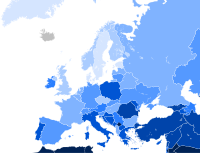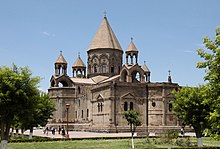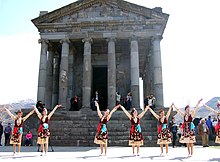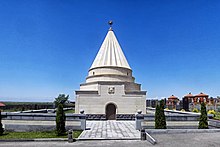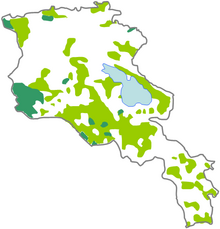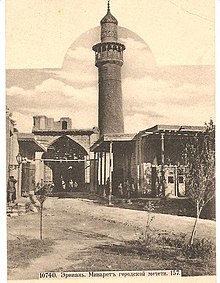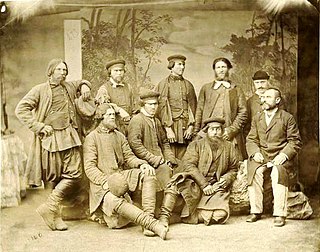
The Molokans are a Russian Spiritual Christian sect that evolved from Eastern Orthodoxy in the East Slavic lands. Their traditions, especially dairy consumption during Christian fasts, did not conform to those of the Russian Orthodox Church, and they were regarded as heretics. The term Molokan is an exonym used by their Orthodox neighbors. Members tend to identify themselves as Spiritual Christians.
Spiritual Christianity is the group of belief systems held by so-called folk Protestants, including non-Eastern Orthodox indigenous faith tribes and new religious movements that emerged in the Russian Empire. Their origins are varied: some come from Protestant movements imported from Europe to Russia by missionaries, travelers and workers; others from disgust at the behavior of Orthodox priests, still others from the Bezpopovtsy Raskolniks. Those influences have mixed with folk traditions resulted in communities that are collectively called sektanty (sectarians). Such communities were typically documented by Russian Orthodox clergy with a label that described their heresy such as not fasting, meeting on Saturday (sabbatarians), rejecting the spirit, body mutilation (castigators), self-flagellation, or suicide.

Islam is the majority religion in Azerbaijan, but the country is considered to be the most secular in the Muslim world. Estimates include 97.3% and 99.2% of the population identifying as Muslim. Of these, a majority belong to the Shia branch (55-65%), while a significant minority (35-45%) are Sunni. Traditionally, the differences between these two branches of Islam have not been sharply defined in Azerbaijan.
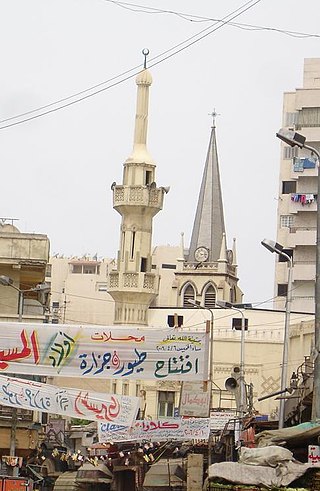
Religion in Egypt controls many aspects of social life and is endorsed by law. The state religion of Egypt is Islam, although estimates vary greatly in the absence of official statistics. Since the 2006 census religion has been excluded, and thus available statistics are estimates made by religious and non-governmental agencies. The country is majority Sunni Muslim, with the next largest religious group being Coptic Orthodox Christians. The exact numbers are subject to controversy, with Christians alleging that they have been systemically under-counted in existing censuses.

Religion has been a major influence on the societies, cultures, traditions, philosophies, artistic expressions and laws within present-day Europe. The largest religion in Europe is Christianity. However, irreligion and practical secularisation are also prominent in some countries. In Southeastern Europe, three countries have Muslim majorities, with Christianity being the second-largest religion in those countries. Ancient European religions included veneration for deities such as Zeus. Modern revival movements of these religions include Heathenism, Rodnovery, Romuva, Druidry, Wicca, and others. Smaller religions include Indian religions, Judaism, and some East Asian religions, which are found in their largest groups in Britain, France, and Kalmykia.

Christianity is the predominant religion in Mexico, with Catholicism being its largest denomination representing around 78% of the total population as of 2020. In recent decades the share of Catholics has been declining, due to the growth of other Christian denominations – especially various Protestant churches, Jehovah's Witness and Mormonism – which now constitute larger shares of the population. Conversion to non-Catholic denominations has been considerably lower than in Central America, and central Mexico remains one of the most Catholic areas in the world.

Yazidis in Armenia are Yazidis who live in Armenia, where they form the largest ethnic minority. Yazidis settled in the territory of modern-day Armenia mainly in the 19th and early 20th centuries, fleeing religious persecution by the Ottoman Empire. While Yazidis were counted as Kurds in censuses for much of the Soviet period, they are currently recognized as a separate ethnic group in Armenia. According to the 2011 census, around 35,000 Yazidis live in Armenia.

Religion in Ethiopia consists of a number of faiths. Among these mainly Abrahamic religions, the most numerous is Christianity totaling at 67.3%, followed by Islam at 31.3%. There is also a longstanding but small Ethiopian Jewish community. Some adherents of the Baháʼí Faith likewise exist in a number of urban and rural areas. Additionally, there is also a substantial population of the adherents of traditional faiths.

Christianity in Azerbaijan is a minority religion. Christians who estimated between 280,000 and 450,000 (3.1%–4.8%) are mostly Russian and Georgian Orthodox. There is also a small Protestant Christian community which mostly came from Muslim backgrounds. Due to the very hostile relations between Azerbaijan and Armenia, Armenian Christians have practically entirely fled the country, and so the Christians in Azerbaijan are members of various other groups, mostly Russians.

Christianity is the dominant religion in Belize. The single largest denomination is the Catholic Church with about 40.1% of the population, a reduction from 49.6% of the population in 2000, 57.7% in 1991 and 61.9% in 1980, although absolute numbers have still risen. Other major groups include Pentecostal with 8.4% of the population up from 7.4% in 2000 and 6.3% in 1991, Seventh-day Adventists with 5.4% of the population up from 5.2% in 2000 and 4.1% in 1991. The following of the Anglican Church has been steadily declining, with only 4.7% of the population in 2010 compared to 6.95% in 1991. About 12,000 Mennonites live mostly in the rural districts of Cayo and Orange Walk. People who declared they belong to no religion make up 15.5% of the population in 2010, more than double their 2000 census numbers. 11.2% adhere to other religions which include the Maya religion, Afro-Caribbean religions, Mormons, Hindus, Buddhists, Muslims, Baháʼís, Rastafarians and others.
The population of Armenia includes various significant minority ethnic groups.

Christianity is the predominant religion in Georgia. The wide variety of peoples inhabiting Georgia has meant a correspondingly rich array of active religions in the country.

In 2020, 85.84% of the population in Georgia adhered to Christianity, 11% were Muslim, 0.1% were Jewish, 0.04% were Baha'i and 3% had no religious beliefs. Other religious groups include Jehovah's Witnesses and Yazidis. Orthodox churches serving other non-Georgian ethnic groups, such as Russians and Greeks, are subordinate to the Georgian Orthodox Church.
According to various polls, the majority of Kazakhstan's citizens, primarily ethnic Kazakhs, identify as Sunni Muslims. In 2020, Shia Muslims made up 0.55% of the population.
The Turkmen of Turkmenistan, are predominantly Muslims. According the U.S. Department of State's International Religious Freedom Report for 2022,
According to U.S. government estimates, the country is 93 percent Muslim, 9 percent Eastern Orthodox, and 2 percent other. There are small communities of Jehovah's Witnesses, Shia Muslims, Baha’is, Roman Catholics, the International Society for Krishna Consciousness, and evangelical Christians, including Baptists and Pentecostals. Most ethnic Russians and Armenians identify as Orthodox Christian and generally are members of the Russian Orthodox Church or Armenian Apostolic Church. Some ethnic Russians and Armenians are also members of smaller Protestant groups. There are small pockets of Shia Muslims, consisting largely of ethnic Iranians, Azeris, and Kurds, some located in Ashgabat, with others along the border with Iran and in the western city of Turkmenbashy.
The Constitution of Armenia as amended in December 2005 provides for freedom of religion; however, the law places some restrictions on the religious freedom of adherents of minority religious groups, and there were some restrictions in practice. The Armenian Apostolic Church, which has formal legal status as the national church, enjoys some privileges not available to other religious groups. Some denominations reported occasional discrimination by mid- or low-level government officials but found high-level officials to be tolerant. Jehovah's Witnesses reported that judges sentenced them to longer prison terms for evasion of alternative military service than in the past, although the sentences were still within the range allowed by law. Societal attitudes toward some minority religious groups were ambivalent, and there were reports of societal discrimination directed against members of these groups.

Christianity is the predominant religion in Kiribati, with Catholicism being its largest denomination.
The Baháʼí Faith in Kazakhstan began during the policy of oppression of religion in the former Soviet Union. Before that time, Kazakhstan, as part of the Russian Empire, had indirect contact with the Baháʼí Faith as far back as 1847. Following the arrival of pioneers the community grew to be the largest religious community after Islam and Christianity, although only a minor percent of the national whole. By 1994 the National Spiritual Assembly of Kazakhstan was elected and the community had begun to multiply its efforts across various interests. The Association of Religion Data Archives estimated some 6,400 Baháʼís in 2005.
The earliest contact documented to date, between Armenians and the Bábí-Baháʼí religion began on an unfortunate note in the banishments and execution of the Báb, the Founder of the Bábí Faith, viewed by Baháʼís as a precursor religion, but ended courageously to the credit of the Armenian officer. In that same year the teachings of the new religion were taken to Armenia. More research is necessary to determine the details. Decades later, during the time of Soviet repression of religion, Baháʼís in Armenia were isolated from Baháʼís elsewhere. Eventually, by 1963, Baháʼí communities had been identified in Yerevan and Artez and communication re-established. Later, in the time of Perestroika, when increasing freedoms were allowed, there were enough Baháʼís in some cities that Baháʼí Local Spiritual Assemblies could be formed in those Baháʼí communities in 1991. Armenian Baháʼís were able to elect their own National Spiritual Assembly in 1995. In such a situation, where religious observance had been a criminal activity, a religious census is problematic. Operation World, published in 2001, approximated the number of Baháʼís in Armenia at 1400. Three years later, Baháʼís counted only about 200. Baháʼís generally count only adult voting members of the community, the other may have been statistically generated from a random sample to include all ages.
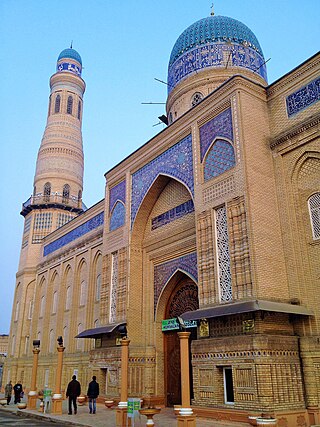
Islam is the predominant religion in Uzbekistan.
